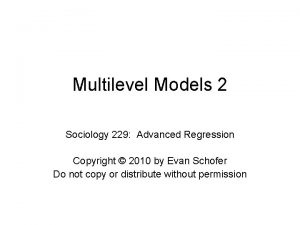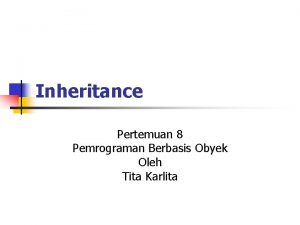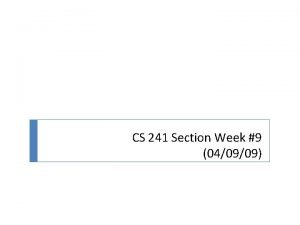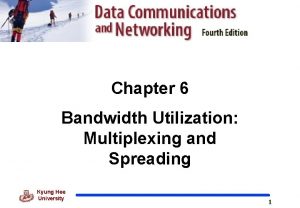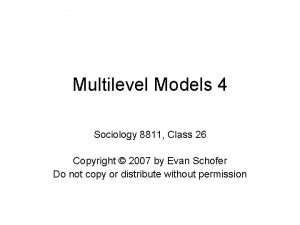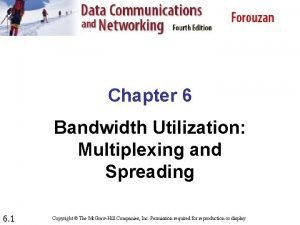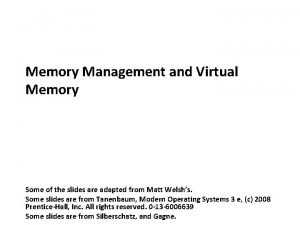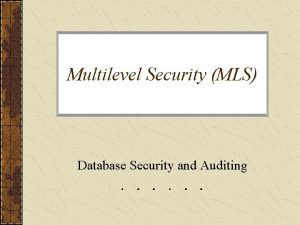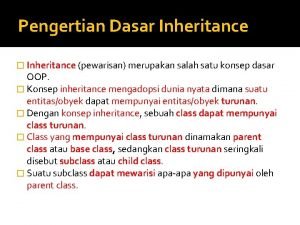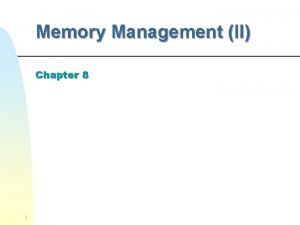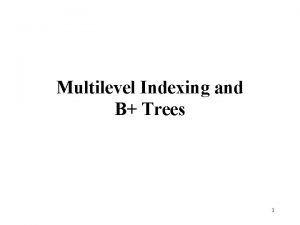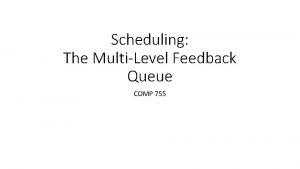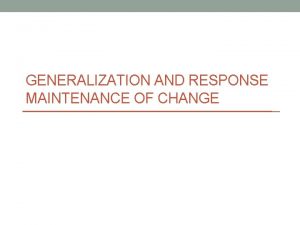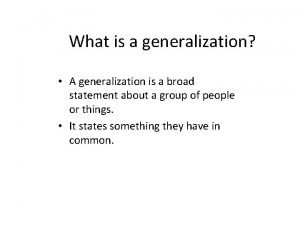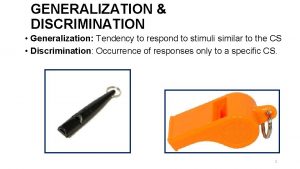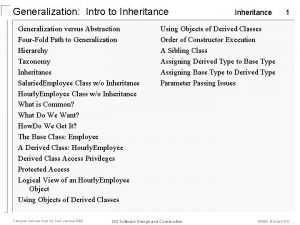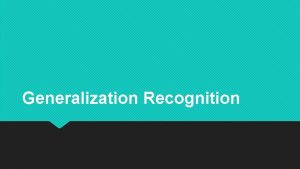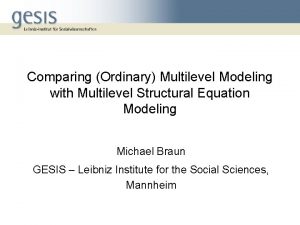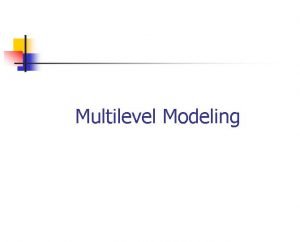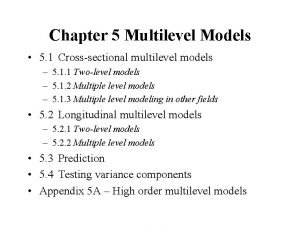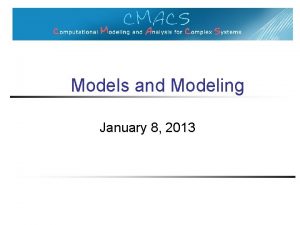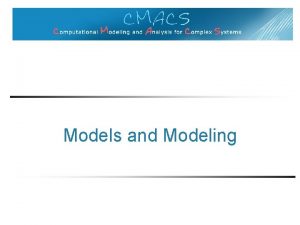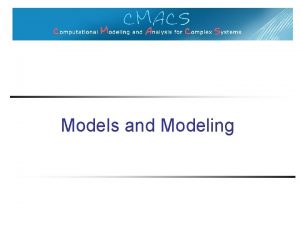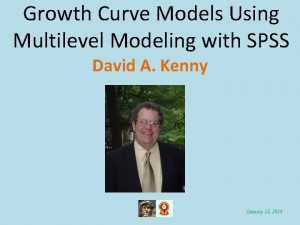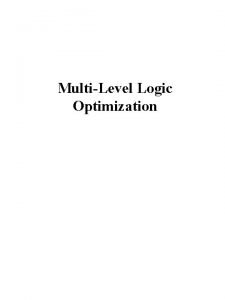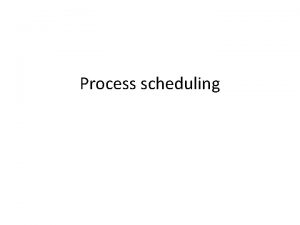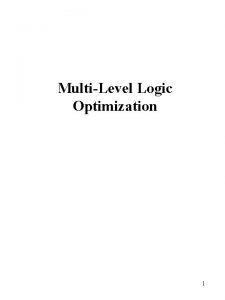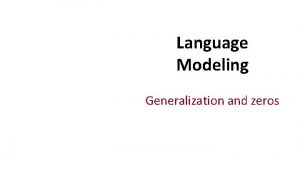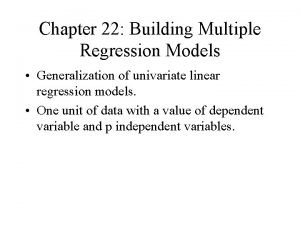Multilevel Models Multilevel modeling is a generalization of


























- Slides: 26

Multilevel Models • Multilevel modeling is a generalization of regression methods. • Used for a variety of purposes, including prediction, data reduction, and causal inference. • From experiments and observational studies.

Hierarchical Data • Data structures are often hierarchical or “nested” • Examples: – Children nested within classrooms – Data points nested within people – Employees nested within organizations – Patients nested within hospitals – Patients nested within doctors nested within clinics Slide 2

Multilevel Models • Many names for similar models, analyses, and goals: • Multi-level model • Random effects model • Mixed model • Random coefficient model • Hierarchical model • Multilevel models are extensions of regression…

A Two-Level Hierarchy Level 2 1 Class 1 Class 2 Class 3 Class 4 Class 5 Class 6 Class n Child 1 Child 9 Child 13 Child 20 Child 28 Child 33 Child a Child 2 Child 10 Child 14 Child 21 Child 29 Child 34 Child b Child 3 Child 11 Child 15 Child 22 Child 30 Child 35 Child c Child 4 Child 12 Child 16 Child 23 Child 31 Child 36 Child d Child 32 Child 37 Child e . . . Child 5 Child 17 Child 24 Child 6 Child 18 Child 25 Child 7 Child 19 Child 26 Child 8 Child 27 Child 38

A Three-Level Hierarchy

Radon Example • I use an example from Gelman’s book: “Data Analysis Using Regression and Multilevel/Hierarchal Models” • Document the strengths and limitations of multilevel modeling.

Background • Effect of city-level policies on enforcing child support payments from unmarried fathers. • Treatment is at the group (city) level. • Outcome is measured on the individual family label.

Benefits of Multilevel Models • Homogeneity of regression slopes – Model the variability in regression slopes • Assumption of independence – You can model the relationships between cases – (Regression for repeated observations) • Missing data – MLMs can cope with missing data

An Example: Cosmetic Surgery • Post_Qo. L – This is a measure of quality of life after the cosmetic surgery. • Base_Qo. L – Quality of life before the surgery. • Surgery – A dummy variable that specifies whether the person has undergone cosmetic surgery (1) or whether they are on the waiting list (0). • Clinic – Which of 10 clinics the person attended to have their surgery. • Age – The person’s age in years. • BDI – Natural levels of depression measured using the Beck Depression Inventory (BDI). • Reason – This dummy variable specifies whether the person had/is waiting to have surgery purely to change their appearance (0), or because of a physical reason (1). • Gender – Whether the person was a man (1) or a woman (0).

Fixed vs. Random Coefficients • Intercepts and slopes can be fixed or random – In OLS regression they are fixed • Fixed coefficients – Intercepts/slopes are assumed to be the same across different contexts • Random coefficients – Intercepts/slopes are allowed to vary across different contexts

Fixed Slope, Random Intercept

Random Slope, Fixed Intercept

Random Slope, Random Intercept

How to Represent These Models • Fixed intercepts and slopes • Random intercepts and fixed slopes • Fixed intercepts and random slopes • Random intercepts and random slopes

The Surgery Example • Fixed intercepts and slopes • Random intercepts and random slopes

Comparing Models • Models should be built up gradually – Start with fixed coefficients – Change one aspect of the model and compare to the previous with the change in the – 2 LL • Assessing fit – AIC – BIC

Covariance Structures • Variance components – Random effects are independent with similar variances • Diagonal – Random effects are independent with different variances • AR(1) – Random effects are related with data points closer in time being more similar than those distant in time – Variances of random effects are similar • Unstructured – Covariances and variances of random effects are unpredictable

Centering • Grand mean centering – Take each score and subtract from it the mean of all scores (for that variable) • Group mean centering – Take each score and subtract from it the mean of scores from the same group (for that variable) • Effects of centering in multilevel models – The effects are complicated – Models using centred variables tend to be more stable – It can help with problems of multicollinearity

Picturing the Data

Compare Models • We can have a look at how the fit of the models has improved using the anova() function that we used before; the following will compare all three models that we have so far fitted): anova(random. Intercept. Only, random. Intercept. Surgery. Qo. L)

Compare Models

An Example: The `Honeymoon Period’ • Speed dating event – After a speed dating event data were collected on all people who ended up in a relationship with the person that they met on the speed dating night. – None of the people measured were in the same relationship. • Satisfaction_Baseline – A 10 -point scale (0 = completely dissatisfied, 10 = completely satisfied) • Satisfaction_6_Months – Life satisfaction at 6 months (0– 10) • Satisfaction_12_Months – Life satisfaction at 12 months (0– 10) • Satisfaction_18_Months – Life satisfaction at 18 months (0– 10) • Gender

The Data

Restructuring Data • Data entry for multilevel models … – Need the variable Time to be represented by a single column. We refer to this format as the ‘long’ format. As such we need to restructure the data. – But, in repeated measures designs we’re used to entering data so that instances of the outcome appear in different columns.

Introducing Random Slopes • We use the update() function to create a new model (called time. RS) which is identical to the previous model (time. RI) but updates the random part of the model to be random = ~Time|Person: time. RS<-update(time. RI, random = ~Time|Person)

To Sum Up … • Data can be hierarchical and this hierarchical structure can be important. – Most of the tests that you learn simply ignore the hierarchy. • Hierarchical models are just a fancy regression in which you can estimate the variability in the slopes and intercepts within entities. – Slopes and intercepts can be random variables (allowed to vary) rather than fixed (assumed to be equal in different situations). • Start with a model that ignores the hierarchy and then add in random intercepts and slopes to see if they improve the fit of the model. • Growth curves model trends in the data over time – These trends can also have variable intercepts and slopes. Slide 26
 Multilevel modeling spss
Multilevel modeling spss What are multilevel security models?
What are multilevel security models? Advanced regression and multilevel models
Advanced regression and multilevel models Erickson nursing theory
Erickson nursing theory Relational vs dimensional data modeling
Relational vs dimensional data modeling What is modals and semi modals
What is modals and semi modals Contoh multilevel inheritance
Contoh multilevel inheritance Multilevel page tables
Multilevel page tables Multilevel page table
Multilevel page table Multilevel multiplexing
Multilevel multiplexing Multilevel nand circuits
Multilevel nand circuits Multilevel model equation example
Multilevel model equation example Multilevel multiplexing
Multilevel multiplexing Priority scheduling in os
Priority scheduling in os Multilevel page tables
Multilevel page tables Multilevel security in database
Multilevel security in database Teaching multilevel esl classes
Teaching multilevel esl classes Contoh program inheritance hewan
Contoh program inheritance hewan Multilevel paging in os
Multilevel paging in os Celia oyler
Celia oyler Multilevel indexing
Multilevel indexing Preemptive sjf
Preemptive sjf Multilevel feedback queue
Multilevel feedback queue Multi level teaching examples
Multi level teaching examples Multilevel bus architecture
Multilevel bus architecture Multilevel scheme in data communication
Multilevel scheme in data communication Miller indices visualizer
Miller indices visualizer


